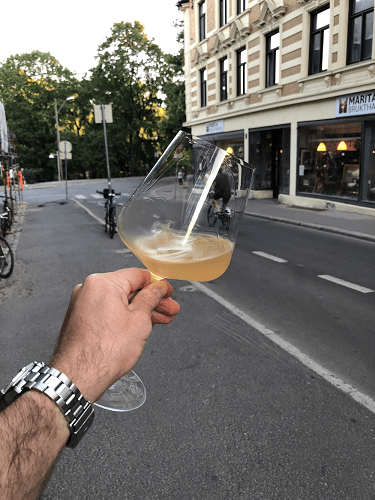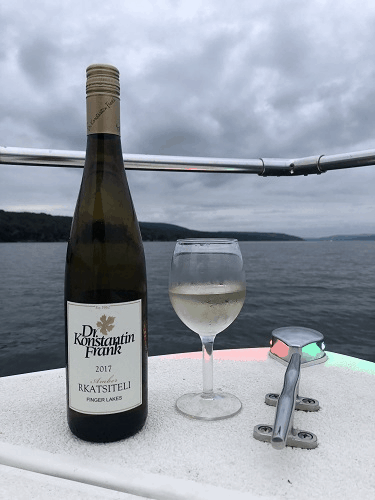It’s Orange Wine Time: Orange Wine 101
For those of you who may not be aware, October 6th is National Orange Wine Day! It was established by a good friend of mine and Winetraveler team member, Amanda Claire Goodwin, who has a real passion for this style of wine production.

What is Orange Wine?
Orange wine is nothing new. It’s actually an ancient style of wine production and its origins can be traced back at least 6,000 years to Georgia (the country). In short, it involves producing white wines that have been allowed to ferment while still being in contact with the grape skins. This was done in ancient Europe within clay “amphorae.” These egg-shaped clay vessels would house the wine while it aged. Today, amphora are still used by some producers, but it can also be stainless-steel fermented, barrel fermented and aged.
Typically, after crushing, white wines have their skins removed while the juice ferments — yielding the common, non-tannic white wines that we know and love today. Orange wine deviates drastically from this method.
So what does leaving grape skins in contact with the juice do to a white wine?
By leveraging “skin-contact” with white wines, producers are able to extract additional color, tannins and flavor that would not normally be present. In some cases, skin-fermented white wines can show orange-colored hues, tannic-texture (such as the subtle feeling of chalkyness on the palate), and flavor profiles reminiscent of apricot, honey, hazelnut, orange rind, lemon spices, apples, baking spices and even chickenstock.
While any white wine grape variety can be used to produce Orange Wine, some grape varieties are utilized more than others. These include Chardonnay, Rkatsiteli (Georgian), Sauvignon Blanc, Pinot Grigio and Semillon.


Common Misconceptions About Orange Wine
Orange Wine is wine that tastes like oranges…
While not totally incorrect, orange wine does not always have an orange flavor. It’s more commonly given this attribution due to its color, and subtle orange rind tasting note.
Orange wine uses oranges during production…
The orange fruit itself is not used in traditional orange wine production. If it has been, then it’s not an orange wine. It would be referred to as a fruit wine.
Additional orange wine designations…
Other names are often used to describe orange wine in various wine regions, leading people to believe they are a different style of wine. In fact, “Amber” and “Ramato” are simply other names for Orange Wine.
Wine Regions Commonly Associated with Orange Wine Production
- Kakheti, Georgia
- Brda, Slovenia
- Friuli-Venezia Giulia, Italy
- Sicily, Italy
- Swartland Region Western Cape, South Africa
- Long Island, NY, USA
- Adelaide and Victoria, Australia
- Strohmeier, Austria
- Sierra Foothills and Napa Valley, CA, USA
- Finger Lakes Region, NY, USA
- Spain, Greece, Argentina, Chile, Oregon, Czech Republic, France, Croatia
- Other areas are beginning to experiment with Orange Wine making (ie; Maryland and Illinois)
Want to learn more about Orange Wine and stay up to date with what’s trending? Follow the official National Orange Wine Instagram account, @orangewinetime.
If you enjoyed this guide, consider joining the Winetraveler Facebook Group to connect with other Winetravelers and for additional travel inspiration around the world. We also highly recommend taking a look at some specific Orange Wines to try and what foods to pair them with.

I am just learning about orange wines. Tasted one yesterday from Troon Vineyards in southern Oregon
It’s been amazing to see how quickly Orange wines are growing in popularity. 2 years ago, we rarely saw one on a wine list, now they seem to be available almost everywhere. We’ve tried a couple and are still “researching” ;). Great article!
Interesting explanation of how orange wines are produced. Just leaving contact with the skins makes that much difference?
I’ve heard of orange wine but I have yet to try it. Thanks for explaining the process for this wine and how leaving the skins on changes the flavor profile. Fascinating! I had no idea that New York was known for this style of wine. Not sure when I’ll be there, but now I know to sample some when I’m there.
We just had and Orange wine from riesling yesterday made in southern Oregon and had several orange pinot gris from the Willamette valley earlier this year! They are going strong in Oregon! Such a great piece on a wine so many y have not yet tasted and might not understand!
I don’t drink so I didn’t know anything about orange wine ????. Somehow wine is a common drink across the world. Thanks for the info and the wine scene in Norway! @knycx.journeying
Oh my, first blue wine and now orange wine. I had no idea and you say its not new. I really want to go to the Finger Lakes so I will have to check it out when I am there. So cool.
I always wondered about white wine grapes with their skins on, a-la red wine production. I also wonder about red wine that keeps the skins but looses the grape seeds. I could imagine that would reduce the tannin but still have the deep aeromatic tastes. In any event – happy Orange Wine Day.
I have to say I’m so surprised we are still all talking about orange wines six or seven years after the trend hit the market-every somm in SF was waxing poetic about orange wines as far back as 2011 and 12. I guess it didn’t hit the smaller markets til much late? I’m not a big fan-and I am a wine industry professional so of course I say this with some exceptions-sure there are some nice interesting orange wines, and when they are from areas that have always traditionally produced them that is nice. Also great to sit and chat about them and be in those cellars in those countries drinking from amphora and so on. That is special. But I have never found myself wnating to buy a bottle and take it home. And, it’s strange now, but many places are starting to make orange wine in countries where the trend was communicated much later and now they are creating orange wines solely for intl markets because they’ve been told it’s trendy (by magazine headlines..). Let’s see how long this trend continues! Will be interesting.
This is super interesting! Before we moved to Bordeaux a few years ago, we actually lived in the Friuli Venezia Giulia for seven years. And this is really the first I’m hearing about orange wine. I’ve never had it! It sounds interesting and at least it’s made through natural wine production methods, not just colored that way like the blue wine craze that was going around last year. Curious what it tastes like now!
Thanks for the article!! Lots of good info here!